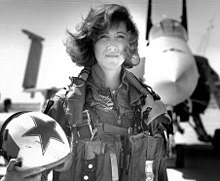
The Blue Angels, formally named the U.S. Navy Flight Demonstration Squadron, are a flight demonstration squadron of the United States Navy. Formed in 1946, the unit is the second oldest formal aerobatic team in the world, after the French Patrouille de France formed in 1931. The team, composed of six Navy and one Marine Corps demonstration pilot, fly Boeing F/A-18 Super Hornets.

USS Lexington (CV/CVA/CVS/CVT/AVT-16) is an Essex-class aircraft carrier built during World War II for the United States Navy. Originally intended to be named Cabot, the new aircraft carrier was renamed while under construction to commemorate the recently-lost USS Lexington (CV-2), becoming the sixth U.S. Navy ship to bear the name in honor of the Battle of Lexington.
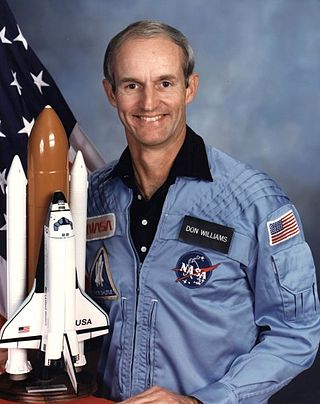
Donald Edward Williams was an American naval officer and aviator, test pilot, mechanical engineer and NASA astronaut. He logged a total of 287 hours and 35 minutes in space.
This is a list of aviation-related events from 1928:

Naval Air Station Glenview or NAS Glenview was an operational U.S. Naval Air Station from 1923 to 1995. Located in Glenview, Illinois, a suburb of Chicago, the air base primarily operated training aircraft as well as seaplanes on nearby Lake Michigan during World War II. Reconfigured as a Naval Air Reserve base following World War II, NAS Glenview supported Naval Air Reserve, Marine Air Reserve/4th Marine Aircraft Wing, and U.S. Army Reserve 244th Aviation Group as well as an active duty Coast Guard Air Station.
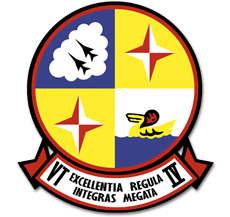
VT-4 Training Squadron 4 is a training squadron of the United States Navy. Initially established as Basic Training Group NINE (BTG-9) in the 1950s, the squadron was redesignated as Training Squadron FOUR (VT-4) on 1 May 1960 and based at Naval Air Station Pensacola, Florida.

Clyde Everett Lassen, a native of Fort Myers, Florida, was a Commander in the United States Navy and a Naval Aviator. He initially served over four years as an enlisted sailor, enlisting in September 1961 and eventually achieving the rate of Aviation Electronics Technician 3rd Class (AT3) prior to being selected as a Naval Aviation Cadet (NAVCAD). Upon completion of flight training as a NAVCAD, he received his wings as a Naval Aviator and his commission as an officer in the rank of Ensign.

Naval Air Station Pensacola or NAS Pensacola, "The Cradle of Naval Aviation", is a United States Navy base located next to Warrington, Florida, a community southwest of the Pensacola city limits. It is best known as the initial primary training base for all U.S. Navy, Marine Corps and Coast Guard officers pursuing designation as naval aviators and naval flight officers, the advanced training base for most naval flight officers, and as the home base for the United States Navy Flight Demonstration Squadron, the precision-flying team known as the Blue Angels.

Kara S. Hultgreen was an American naval aviator who served as a lieutenant in the United States Navy and was the first female carrier-based fighter pilot in the U.S. Navy. She was also the first female fighter pilot in the U.S. military to die in a crash. She died just months after she was certified for combat, when her F-14 Tomcat crashed into the sea on final approach to USS Abraham Lincoln.

A naval aviator is a commissioned officer or warrant officer qualified as a crewed aircraft pilot in the United States Navy or United States Marine Corps. United States Coast Guard crewed aircraft pilots are officially designated as "Coast Guard aviators", although they complete the same undergraduate flight training as Navy and Marine Corps crewed aircraft pilots, and are awarded the same aviation breast insignia.

Strike Fighter Squadron 125 (VFA-125), also known as the "Rough Raiders", is a United States Navy strike fighter squadron based at Naval Air Station Lemoore, California. The "Rough Raiders" are a Fleet Replacement Squadron flying the F-35C Lightning II.
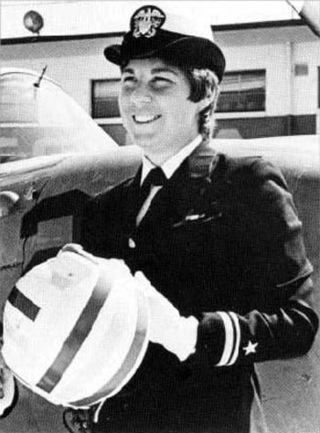
Barbara Ann Allen Rainey was one of the first six female pilots in the U.S. armed forces. Rainey received her wings of gold as the first female to be designated a naval aviator in February 1974 and became the first Navy woman to qualify as a jet pilot. She attained the rank of Lieutenant Commander in the United States Navy. She was killed in an aircraft crash in 1982 while performing her duties as a flight instructor.
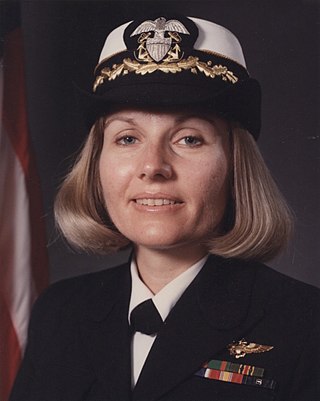
Captain Rosemary Bryant Mariner was an American pilot and one of the first six women to earn their wings as a United States Naval Aviator in 1974. She was the first female military pilot to fly a tactical jet and the first to achieve command of an operational aviation squadron.
Lucy Young is an American naval officer. In 1980 she became the first woman to qualify in Naval Air Combat Maneuvering (ACM). After that, she became an ACM instructor. At that time, female aviators were forbidden from combat duty stations. After she retired from the Navy, she got a job at a legacy carrier and became one of the first female captains.

Thomas McClelland is a decorated U.S. Navy veteran who served in the Vietnam War and Operation Desert Storm.

Richard Halsey Best was a dive bomber pilot and squadron commander in the United States Navy during World War II. Stationed on the aircraft carrier USS Enterprise, Best led his dive bomber squadron at the 1942 Battle of Midway, sinking two Japanese aircraft carriers in one day, before being medically retired that same year due to damage to his lungs caused by breathing bad oxygen during the battle.
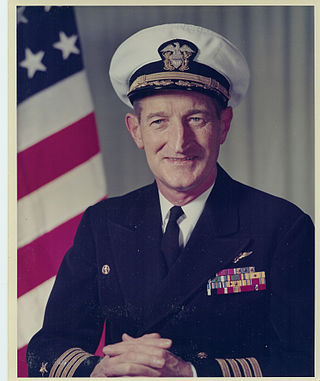
Frederick T. Moore Jr. was a United States Navy captain. During World War II, he was executive officer of Fighter Squadron 1 operating off the carrier USS Yorktown (CV-10) and commanding officer of the Air Group 35 aboard the aircraft carrier USS Chenango in the Pacific. During the Korean War, he was the commanding officer of naval air training at NAS Pensacola and the air officer on USS Coral Sea. His first sea command was aboard USS Suribachi. In 1962–1963, Moore was the eighth commanding officer of USS Saratoga. Late in his career during the Vietnam War, he was Chief of Staff of the Naval Air Training Command at Naval Air Station Pensacola from October 1965 to July 1969.
The US Navy had four programs for the training of naval aviators.
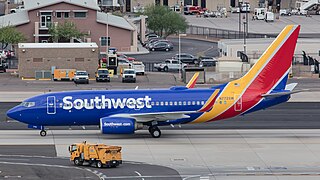
Southwest Airlines Flight 1380 was a Boeing 737-700 that experienced a contained engine failure in the left CFM International CFM56 engine after departing from New York–LaGuardia Airport en route to Dallas Love Field on April 17, 2018. The engine cowl was broken in the failure, and cowl fragments damaged the fuselage, shattering a cabin window and causing explosive depressurization of the aircraft. Other fragments caused damage to the wing. The crew carried out an emergency descent and diverted to Philadelphia International Airport. One passenger was partially ejected from the aircraft and sustained fatal injuries, while eight other passengers sustained minor injuries. The aircraft was substantially damaged.

Amanda Lee is a naval aviator in the United States Navy. She was selected in June 2022 as the first female pilot in the elite Blue Angels fighter jet flight demonstration squadron. Lee made her debut as the Left Wing demo pilot in the number three jet on March 11, 2023, in El Centro, California. She uses the call sign "Stalin".
